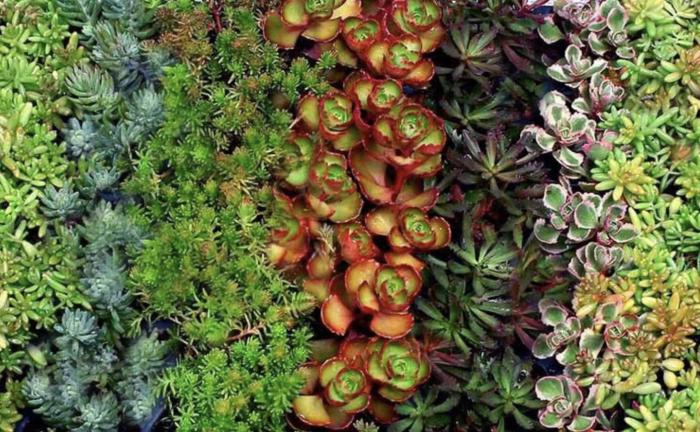Sedum spp.
Stonecrop

Description
Sedum is a large and varied genus in the Crassulaceae family that encompasses more than 450 species. Sedum varieties are native throughout the northern hemisphere, Africa and South America. This genus of succulents is remarkable for its diversity of color, form, texture and even hardiness. Vibrant foliage and fanciful blooms abound. Some sedum are hardy to the bitterly cold climes of zone 3, while others cannot tolerate a hard frost. Some are just a couple of inches tall, making an excellent ground cover, while others reach 2-3 feet and are used as border plants. Still others trail and make dramatic additions to hanging baskets. Like all succulents, sedum store water in their foliage for use during times of drought. They also employ a more specialized strategy for dealing with hot, dry climates. Sedum are often divided in the tall, border varieties that grow 1-3 feet tall, and the groundcover sedum. In fact, horticulturalists and taxonomists have recently reclassified the border sedums as Hylotelephium – separate from the sedum genus. But this focus on size seems to be missing the point. Certainly, if you are looking for a groundcover, or specifically for a border plant, knowing the plant’s mature size is important. But I feel that dividing sedum into cold-hardy varieties and those tender to frost is more valuable to the home gardener. Many of the tallest and the smallest sedum thrive in climates with snow and sleet. Sedum are cherished the world over for their bright foliage, long-lasting blooms and easy care nature. Some varieties have been used as a food source, others are integral in beauty products. Sedum are invaluable in the growing movement toward “green roofs”, where they are often interplanted with sempervivum. Green roofs or living roofs provide tremendous insulation, thereby cutting energy use and costs. They absorb rainwater, create habitat and support for wildlife and mitigate the heat island effect in cities. Although many varieties of sedum are hardy to zone 3, there is a large subset of varieties that are not hardy below zone 9! These tender sedum varieties are typically small-leafed, with vivid foliage and bright, colorful flowers that are highly appealing to butterflies. They are excellent for use in rock gardens and containers, happily growing outdoors year round in very mild climates. They will over-winter indoors where winter is cold. Just provide as much light as possible. All sedum varieties, both tall and small, hardy and tender, produce wonderfully long-lasting blooms. They are a good source of nectar for butterflies and bees, and lend colorful texture to the garden. Bloom times vary widely, and it is possible to plant a garden that ensures sedums are in bloom nearly all year round. The flowering stems of the tall, border varieties make excellent cut flowers with a good vase life. Like all succulents, sedum requires fast-draining, nutritionally lean soil to thrive. Though not as sensitive as some succulents, sedum do require a light hand with the water.
Plant Type
Succulent
Height Range
Under 1', 1-3'
Width Range
Flower Color
Orange, Pink, Yellow, Violet
Flower Season
Spring, Summer, Fall
Leaf Color
Green, Light Green, Grey, Red, Yellow, Variegated
Bark Color
n/a
Fruit Color
n/a
Fruit Season
n/a
Sun
Full, Half
Water
Low
Growth Rate
Soil Type
Sandy, Loam, Rocky
Soil Condition
Average, Well-drained, Dry
Soil pH
Neutral
Adverse Factors
n/a
Design Styles
Meadow, Mediterranean, Ranch, Seascape, Spanish, Woodland
Accenting Features
Fall Color, Showy Flowers, Unusual Foliage, Unusual Shape
Seasonal Interest
Spring, Summer, Fall
Location Uses
Entry, Perennial Border, Indoor, Patio, Walkways, With Rocks
Special Uses
Container, Cut Flowers, Erosion Control, Filler, Mass Planting, Hanging Baskets
Attracts Wildlife
Butterflies
Water Saving Tip:
Water high water-use plants separately from low water-use plants.
Low water-use plants can grow with one-half the water needed by high water-use plants, and can be easily damaged from over watering.